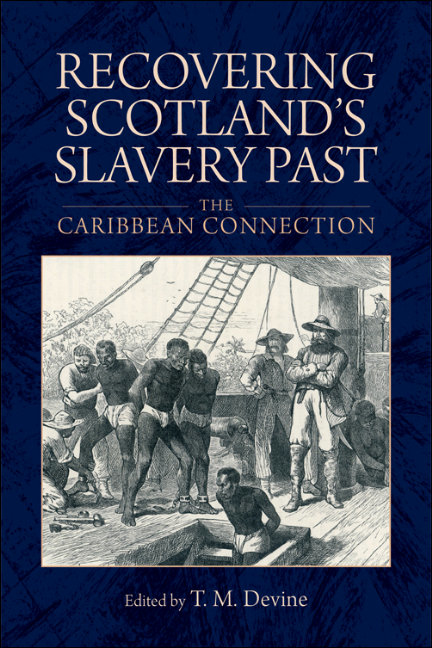Book contents
- Frontmatter
- Contents
- List of Illustrations and Tables
- List of the Contributors
- Acknowledgements
- Foreword
- map
- Introduction: Scotland and Transatlantic Slavery
- 1 Lost to History
- 2 Yonder Awa: Slavery and Distancing Strategies in Scottish Literature
- 3 Early Scottish Sugar Planters in the Leeward Islands, c. 1660–1740
- 4 The Scots Penetration of the Jamaican Plantation Business
- 5 ‘The habits of these creatures in clinging one to the other’: Enslaved Africans, Scots and the Plantations of Guyana
- 6 The Great Glasgow West India House of John Campbell, senior, & Co.
- 7 Scottish Surgeons in the Liverpool Slave Trade in the Late Eighteenth and Early Nineteenth Centuries
- 8 Scotland and Colonial Slave Ownership: The Evidence of the Slave Compensation Records
- 9 ‘The Upas Tree, beneath whose pestiferous shade all intellect languishes and all virtue dies’: Scottish Public Perceptions of the Slave Trade and Slavery, 1756–1833
- 10 ‘The most unbending Conservative in Britain’: Archibald Alison and Pro-slavery Discourse
- 11 Did Slavery make Scotia Great? A Question Revisited
- Conclusion: History, Scotland and Slavery 246
- Index
9 - ‘The Upas Tree, beneath whose pestiferous shade all intellect languishes and all virtue dies’: Scottish Public Perceptions of the Slave Trade and Slavery, 1756–1833
Published online by Cambridge University Press: 15 December 2017
- Frontmatter
- Contents
- List of Illustrations and Tables
- List of the Contributors
- Acknowledgements
- Foreword
- map
- Introduction: Scotland and Transatlantic Slavery
- 1 Lost to History
- 2 Yonder Awa: Slavery and Distancing Strategies in Scottish Literature
- 3 Early Scottish Sugar Planters in the Leeward Islands, c. 1660–1740
- 4 The Scots Penetration of the Jamaican Plantation Business
- 5 ‘The habits of these creatures in clinging one to the other’: Enslaved Africans, Scots and the Plantations of Guyana
- 6 The Great Glasgow West India House of John Campbell, senior, & Co.
- 7 Scottish Surgeons in the Liverpool Slave Trade in the Late Eighteenth and Early Nineteenth Centuries
- 8 Scotland and Colonial Slave Ownership: The Evidence of the Slave Compensation Records
- 9 ‘The Upas Tree, beneath whose pestiferous shade all intellect languishes and all virtue dies’: Scottish Public Perceptions of the Slave Trade and Slavery, 1756–1833
- 10 ‘The most unbending Conservative in Britain’: Archibald Alison and Pro-slavery Discourse
- 11 Did Slavery make Scotia Great? A Question Revisited
- Conclusion: History, Scotland and Slavery 246
- Index
Summary
ALTHOUGH, IN THE PLANTATIONS, they have laid hold of the poor blacks and made slaves of them, yet I do not think that that is agreeable to humanity, not to say to the Christian religion. Is a man a slave because he is black? No. He is our brother; and he is a man, though not our colour, he is in the land of liberty, with his wife and child, let him remain there.’ Alexander Boswell, Lord Auchinleck, addressed these words in January 1788 to his fellow judges in the Court of Session in Edinburgh. They found, by a majority of eight to four, that the state of slavery was not recognised by the laws of Scotland, and Joseph Knight, a slave from Jamaica, was freed from the service of Sir John Wedderburn of Ballindean in Perthshire.
There are distinct threads that run through Scottish thinking on slavery in the late eighteenth and early nineteenth centuries, two of which found an echo in Auchinleck's statement. The Scottish intelligentsia, possibly feeling the loss of national identity in the wake of the Union, were concerned about a self-image that encapsulated civilisation and humanity. Scots may have had an unusually harsh reputation in the colonies for their treatment of slaves, but they were keen to hide that from their countrymen at home. Robert Burns's poignant The Slave's Lament touched a popular chord, as did other poems proclaiming human feeling for others, even though the author was within an ace of sailing for Jamaica to help run a slave plantation.
Another obvious strand was commerce. The fact that the wealth of Glasgow and other parts of Scotland, based on tobacco, sugar and cotton, was dependent on slavery, is demonstrated in Chapter 11. Scottish mariners were extensively involved in the slave trade, and Scottish cheap linen clothed bondsmen and women in the plantations. In a bizarre twist, those caddying for ships’ captains on a two-hole golf course on Bance Island, the slave station on the Sierra Leone river, were dressed in tartan manufactured in Bannockburn. Economic ties with the trade and plantation slavery were emphasised by those who opposed the moves for abolition. The Glasgow Courier carried continuous reminders of this, with castigation of any who argued against the slave trade.
- Type
- Chapter
- Information
- Recovering Scotland's Slavery PastThe Caribbean Connection, pp. 187 - 205Publisher: Edinburgh University PressPrint publication year: 2015



